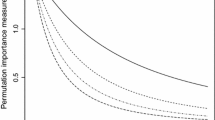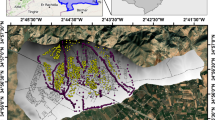Abstract
Spatial data classification and extraction is a significant problem to be resolved in data mining. The classification performance of existing techniques was not effectual to accurately mine the interesting spatial data. Furthermore, the amount of time taken for classifying the spatial data location was very higher. In order to resolve the above limitations, an Exponentiated Pareto based linear assorted classification method is introduced to reduce the incorrect classification of spatial data. This paper begins with a discussion of traditional methods of spatial data mining. The algorithm makes an association rule with spatial data objects. The technique conducts the experimental works using metrics such as classification accuracy, time complexity, space complexity and false positive rate with respect to different number of data. The proposed approach takes the forest fire dataset and El Nino dataset as input and predicts the burned area of forest fires and weather and climate conditions. The experimental results show that the proposed technique is able to increase the classification accuracy and reduce the time complexity as well as space complexity and false positive rate of spatial data mining as compared to state-of-the-art works.











Similar content being viewed by others
References
Tehrany M S, Jones S, Shabani F, Martínez-Álvarez F and Bui D T 2018 A novel ensemble modeling approach for the spatial prediction of tropical forest fire susceptibility using LogitBoost machine learning classifier and multi-source geospatial data. Theor. Appl. Climatol, 137: 637-653, 1-17
Pham B T, Prakash I and Bui D T 2017 Spatial Prediction of Landslides Using Hybrid Machine Learning Approach Based on Random Subspace and Classification and Regression Trees. Geomorphology 303: 256-270
Li H, Song Y and Chen C L P 2017 Hyperspectral Image Classification based on Multiscale Spatial Information Fusion. IEEE Trans. Geosci Remote Sens. 55: 5302-5312
Ojaghi S, Ahmadi F F and Ebadi H 2016 A new method for semi-automatic classification of remotely sensed images developed based on the cognitive approaches for producing spatial data required in geomatics applications. Arab. J. Geosci., 9: 1-12
Oliker N, Ohar Z and Ostfeld A 2016 Spatial event classification using simulated water quality data. Environ. Model. Softw. 77: 71-80
Hou B, Huang T, Jiao L 2015 Spectral-Spatial Classification of Hyperspectral Data Using 3-D Morphological Profile. IEEE Geosci. Remote. Sens. Lett. 12: 1-5
Ghamisi P, Benediktsson J A, Cavallaro G and Plaza A 2014 Automatic Framework for Spectral-Spatial Classification Based on Supervised Feature Extraction and Morphological Attribute Profiles. IEEE J. Sel. Top Appl. Earth Obs. Remote Sens. 7: 2147 – 2160
Maiti S and Subramanyam R B V 2018 Mining co-location patterns from distributed spatial data, J. King Saud Univ., Comp. & Info. Sci. pp. 1-10
Barua S and Sander J 2014 Mining Statistically Significant Co-location and Segregation Patterns. IEEE Trans. Knowl. Data Eng. 26: 1185-1199
Jayababu Y, Varma G P S and Govardhan A 2017 Incremental topological spatial association rule mining and clustering from geographical datasets using probabilistic approach. J. King Saud Univ., Comp. & Info. Sci. 30: 510-523
Ding Q, Ding Q and Perrizo W 2008 PARM—An Efficient Algorithm to Mine Association Rules From Spatial Data. IEEE Trans. Syst., Man, Cybern. B. Cyber, 38: 1513-1524
Guo Y, Gao J, Li F 2015, Random spatial-subspace clustering. Knowl. Based Syst. 74: 106-118
Jiang Z, Shekhar S, Zhou X, Knight J and Corcoran J 2015 Focal-Test-Based Spatial Decision Tree Learning. IEEE Trans. Knowl. Data Eng. 27: 1547 – 1559
Yan X, Ai T, Yang M and Yin H 2019 A graph convolutional neural network for classification of building patterns using spatial vector data. ISPRS J. Photogramm. Remote Sens. 150: 259-273
Vasuki Y, Yu L, Holden E, Kovesi P, Wedge D and Grigg A H 2018 The spatial-temporal patterns of land cover changes due to mining activities in the Darling Range, Western Australia: A Visual Analytics Approach. Ore Geol. Rev. 1-41
Kumar C N S, Ramulu V S, Reddy K S, Kotha S and Kumar C M 2012 Spatial Data Mining using Cluster Analysis. International Journal of Computer Science & Information Technology, 4:71-77
Kumar R, Chundawat D S and Singh P K 2014 SVM Based Spatial Data Mining for Traffic Risk Analysis. International Journal of Engineering Research and General Science, 2: 716-718
Sananse D A and Tuteja R R 2015 Association Rules Mining Technique Based on Spatial Data Classification. International Journal of Computer Science Engineering and Technology, 5: 131-136
Lakumarapu S and Agarwal D R 2016, Classification of Spatial Data Mining Algorithm by Clustering Technique. International Journal of Electronics, Electrical and Computational System, 5: 59-64
Hemalatha D M and Saranya N N 2011 A Recent Survey on Knowledge Discovery in Spatial Data Mining. International Journal of Computer Science Issues, 8: 473-479
Banupriya R and Kannan A R 2020 Satellite image based flood classification in urban areas using B-convolutional networks. Sādhanā, 45: 1-5
Panigrahi S, Verma K and Tripathi P 2017 Data mining algorithms for land cover change detection: a review. Sādhanā, 42: 2081–2097
Jadhav P and Kshirsagar S 2016 Efficient rate control scheme using modified inter-layer dependency for spatial scalability. Sādhanā, 41: 1415–1424
Cortez P and Morais A 2007 Forest Fires Dataset [dataset]. UCI Machine Learning Repository https://archive.ics.uci.edu/ml/datasets/forest+fires
Pacific Marine Environmental Laboratory, National Oceanic and Atmospheric Administration, US department of Commerce 1999 El Nino dataset [dataset]. UCI Machine Learning Repository, https://archive.ics.uci.edu/ml/datasets/El+Nino
Author information
Authors and Affiliations
Corresponding author
Rights and permissions
About this article
Cite this article
Sheena Smart, P.D., Thanammal, K.K. & Sujatha, S.S. A novel linear assorted classification method based association rule mining with spatial data. Sādhanā 46, 7 (2021). https://doi.org/10.1007/s12046-020-01548-2
Received:
Revised:
Accepted:
Published:
DOI: https://doi.org/10.1007/s12046-020-01548-2




